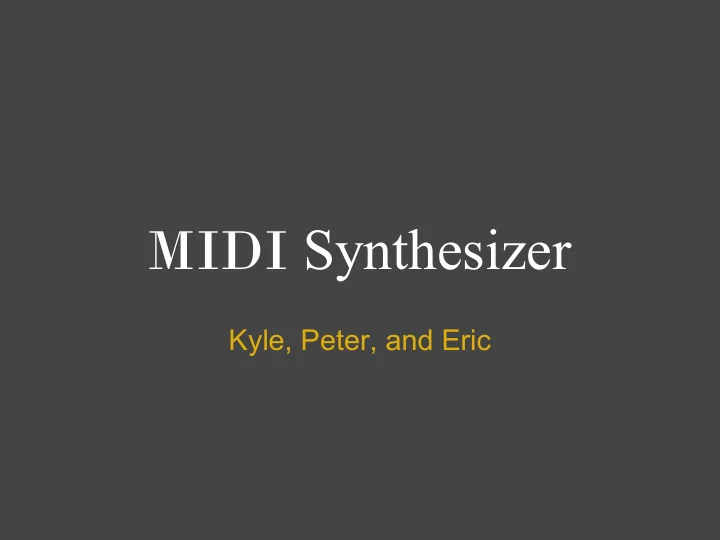

MIDI Synthesizer Kyle, Peter, and Eric
Current Work Accomplished Kyle: Started work on envelope generator. Eric: Working on getting Audio Chip interfaced. Peter: Wrote Simple NCO, Working with Eric on Audio Chip
Feature List (BASIC FUNCTIONALITY) (POSSIBLE ADDITIONS) 1. Play accurate notes when 1. Arpeggiator. keyboard keys are 2. Display notes played on pressed, via the MIDI screen. protocol. 3. Multiple sound sets. 2. Ability to add effects. 4. External Custom MIDI (Wah, Tremelo, Vibrato) Instrument. 3. Pre-recorded performances (MIDI Files) 4. Up to 10 keys played at once. 5. 48kHz 16bit Audio
Motivation ● Digital synthesis is an interesting area. ● Straightforward core project with lots of room for expansion. ● Fun demonstration. ● Something a bit different. ● Interesting DSP applications.
Basic Functionality Component Diagram
Challenges The challenges currently ahead. 1. Create the VHDL components for basic functionality 2. Connecting the components together 3. Create MIDI controller in MicroC/OS II on NIOS II 4. Connect the external components, keyboard, speakers
Components Hardware Based: ● Physical MIDI Interface to UART FPGA Based: ● Numerically Controlled Oscillator ● Envelope Generators ● Mixer ● Effects Core ● Volume Control
Code Example entity nco is port ( clk : in std_logic; -- System Clock rst : in std_logic; -- Reset nco_inc : in std_logic_vector(31 downto 0); --Freq Increment wave_out : out std_logic_vector(11 downto 0) --Output Waveform ); end nco ; architecture arch of nco is component lut port ( clk : in std_logic; --Clock addr : in std_logic_vector(11 downto 0); --Address in LUT waveform : out std_logic_vector(11 downto 0) --Waveform Val ); end component ; signal accumulator : std_logic_vector(31 downto 0); signal lut_address : std_logic_vector(11 downto 0);
Code Example begin -- arch 2 lut_address <= accumulator(31 downto 20); --12 bits=4096 samples inc : process (clk, rst) begin if rst = '0' then accumulator <= x"00000000"; elsif rising_edge(clk) then accumulator = unsigned(accumulator) + unsigned(nco_inc); end if ; end process ; lut : lut port map ( clk => clk, addr => lut_address, waveform => wave_out ); end arch ;
Test Plan We will be testing each component as we complete them. Then do various integration tests as the system is connected together. ● NIOS II: To test setup, connection and operation we will compile and run a simple program. Will also be used used for other tests. ● RAM: We will test connection and functionality by running a standard memory tester. Similar to Lab 1. ● Flash: To test connection,storage and loading we will store and load a simple program on the flash. Power cycle the board and have the program start and run from flash. ● MIDI Controller: We will write testing harnesses to simulate input and verify the expected output is produced.
Test Plan ● MIDI Input: We will test proper connection and signal reading by connecting the keyboard, pressing a key and having it displayed on the LCD. ● Sub-components: For the various sub components that will make up the system (ADSR Envelope generator, oscillators, etc) we will run basic functional testing.
Application Notes ● None so far. ● When we get audio working we'll release that...
MIDI Synthesizer Questions?
Recommend
More recommend